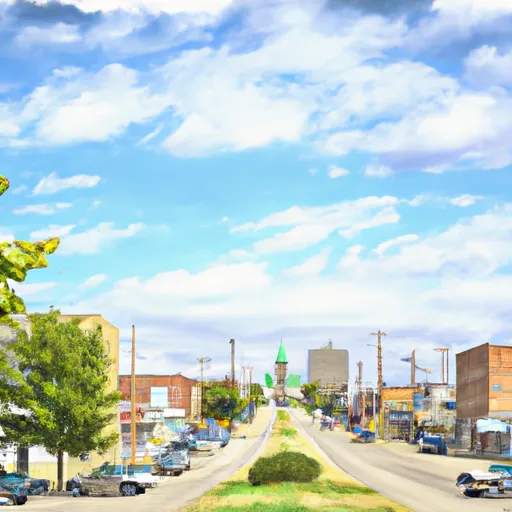-
 Snoflo Premium
Snoflo Premium
Get unlimited access to all our content
With no Ad interruptions! - Start Your Free Trial Login with existing account
Indianola
Eden Index
Climate
7.7
•
Recreation
3.1
•
Community
0.9
•
Safeguard
4.4/10

Indianola, Nebraska is a small town located in southwestern Nebraska, with a population of approximately 650 residents. The climate in Indianola is classified as semi-arid, characterized by hot summers and cold winters. Summers are typically hot, with temperatures often exceeding 90°F (32°C), while winters can be bitterly cold, with temperatures dropping below freezing.
Hydrologically, Indianola is situated in the Upper Republican Natural Resources District, which is primarily dependent on groundwater resources. The constituents of the hydrology in this region include the Republican River and its tributaries, as well as numerous wells that provide water for agriculture and domestic use.
For outdoor enthusiasts, Indianola offers several recreational opportunities. The nearby Medicine Creek Reservoir offers fishing, boating, and camping facilities. The reservoir is known for its abundant population of largemouth bass, catfish, and walleye, making it a popular spot for anglers. Additionally, the area around Indianola is dotted with scenic hiking and biking trails, providing opportunities for outdoor exploration and nature appreciation.
In summary, Indianola, Nebraska experiences a semi-arid climate with hot summers and cold winters. Its hydrology constituents consist of the Republican River, tributaries, and groundwater resources. Outdoor recreation enthusiasts can enjoy fishing, boating, camping, and exploring scenic trails in the vicinity.
What is the Eden Index?
The Snoflo Eden Index serves as a comprehensive rating system for regions, evaluating their desirability through a holistic assessment of climate health, outdoor recreation opportunities, and natural disaster risk, acknowledging the profound impact of these factors on livability and well-being.
Climate Health Indicator (CHI): 7.7
Indianola receives approximately
551mm of rain per year,
with humidity levels near 80%
and air temperatures averaging around
11°C.
Indianola has a plant hardyness factor of
5, meaning
plants and agriculture in this region thrive during a short period during spring and early summer. Most
plants will die off during the colder winter months.
By considering the ideal temperature range, reliable water supplies, clean air, and stable seasonal rain or snowpacks, the Climate Health Indicator (CHI) underscores the significance of a healthy climate as the foundation for quality living.
A healthy climate is paramount for ensuring a high quality of life and livability in a region, fostering both physical well-being and environmental harmony. This can be characterized by ideal temperatures, reliable access to water supplies, clean air, and consistent seasonal rain or snowpacks.
Weather Forecast
Streamflow Conditions
Republican
Area Rivers
Republican
Snowpack Depths
Republican
Reservoir Storage Capacity
Republican
Groundwater Levels
Recreational Opportunity Index (ROI): 3.1
The Recreational Opportunity Index (ROI) recognizes the value of outdoor recreational options, such as parks, hiking trails, camping sites, and fishing spots, while acknowledging that climate plays a pivotal role in ensuring the comfort and consistency of these experiences.
Access to outdoor recreational opportunities, encompassing activities such as parks, hiking, camping, and fishing, is crucial for overall well-being, and the climate plays a pivotal role in enabling and enhancing these experiences, ensuring that individuals can engage in nature-based activities comfortably and consistently.
Camping Areas
| Campground | Campsites | Reservations | Toilets | Showers | Elevation |
|---|---|---|---|---|---|
| Sappa Park | 5 | 2,528 ft | |||
| Sheridan State Fishing Lake | None | 2,536 ft | |||
| Karrer Park | 14 | 2,483 ft |
Catastrophe Safeguard Index (CSI):
The Catastrophe Safeguard Index (CSI) recognizes that natural disaster risk, encompassing floods, fires, hurricanes, and tornadoes, can drastically affect safety and the overall appeal of an area.
The level of natural disaster risk in a region significantly affects safety and the overall livability, with climate change amplifying these risks by potentially increasing the frequency and intensity of events like floods, fires, hurricanes, and tornadoes, thereby posing substantial challenges to community resilience and well-being.
Community Resilience Indicator (CRI): 0.9
The Community Resilience Indicator (CRI) recognizes that education, healthcare, and socioeconomics are crucial to the well-being of a region. The CRI acknowledges the profound impact of these elements on residents' overall quality of life. By evaluating educational resources, healthcare accessibility, and economic inclusivity, the index captures the essential aspects that contribute to a thriving community, fostering resident satisfaction, equity, and social cohesion.

